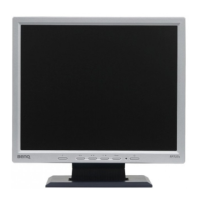
Do you have a question about the BenQ Q7T3-FP737S and is the answer not in the manual?
| Screen Size | 17 inches |
|---|---|
| Resolution | 1280 x 1024 |
| Contrast Ratio | 500:1 |
| Aspect Ratio | 5:4 |
| Panel Type | TN |
| Viewing Angle | 130° vertical |
| Input Connectors | VGA |
Detailed steps for monitor alignment and function adjustment.
Steps to prepare for alignment procedures.
Procedure for adjusting display timing parameters.
Steps for adjusting the monitor's color balance.
Procedure for aligning color temperature.
Process for writing EDID files to EEPROM.
Defines I2C commands for monitor control.
Physical assembly steps for the monitor.
Inspecting components on the bracket.
Connecting internal cables and connectors.
Securing the DVI board with spacers.
Installing interface and power supply boards.
Fastening boards with screws.
Attaching plastic parts and D-sub cover.
Securing the D-SUB cover.
Installing gaskets on the bracket.
Securing the LVDS FFC cable.
Mounting the bracket and connecting FFC.
Installing and securing an iron cover.
Fastening screws on the right side.
Fastening screws on the left side.
Applying aluminum tape to a wire hole.
Attaching spring and control board.
Routing the control board 9-pin wire.
Securing the upper case with screws.
Fastening screws on the column.
Specifications for operating the monitor.
Environmental conditions for operation.
Operating and storage temperature ranges.
Humidity limits for operation and storage.
Altitude limits for operation and storage.
Specifications for transporting the monitor.
Vibration test parameters for packaged units.
Drop test specifications for packaged units.
Details on packing configurations.
Specifications for shipping containers.
Electrostatic Discharge (ESD) compliance requirements.
Compliance with safety standards.
Electromagnetic Interference (EMI) compliance requirements.
Reliability specifications, including MTBF.
Specifications for input/output signals.
Requirements for input video and sync signals.
Functions of the monitor.
Supported display timings and resolutions.
Input and output power specifications.
Optical characteristics of the LCD panel.
All tests performed under standard conditions.
Specifications related to display quality.
Physical specifications of the monitor.
Overall dimensions and appearance details.
Specifications for maintainability.
General requirements for maintainability.
Procedures for repair and calibration.
Mean Time To Repair (MTTR) for modules and components.
Required equipment and tools for service.
Troubleshooting steps for no display or unstable image.
Troubleshooting steps for interface board issues.
Troubleshooting steps for the button function.
Troubleshooting steps for the control board.
Troubleshooting steps for the On-Screen Display function.
Troubleshooting steps for power board issues.
Overview of the LCD monitor's functionality.
Schematic showing the monitor's main components.
Detailed explanation of circuit operations.
Details about the monitor's head section.
Diagram of the interface board.
Explanation of the interface board's operation.
Details on key ICs used on the interface board.
Block diagram of the power supply board.
Overview of the control board components.
Block diagram of the inverter circuit.
